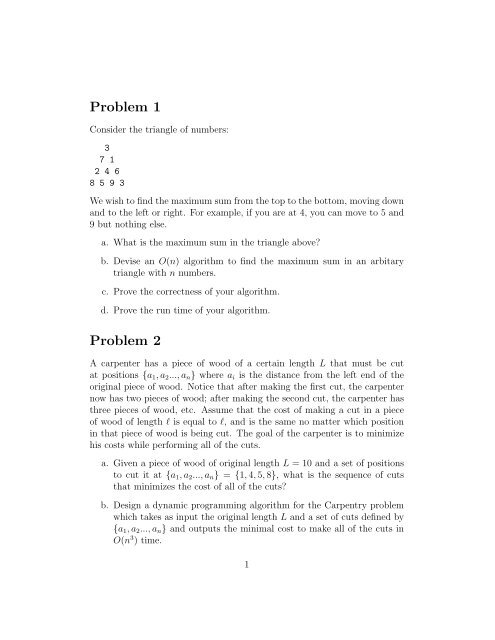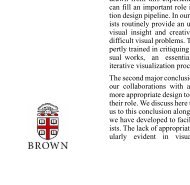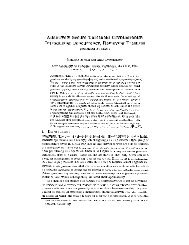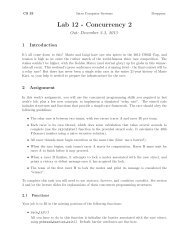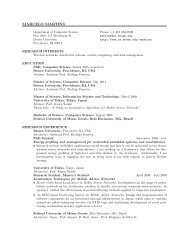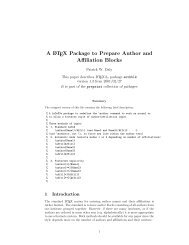Problem 1 Problem 2
Problem 1 Problem 2
Problem 1 Problem 2
You also want an ePaper? Increase the reach of your titles
YUMPU automatically turns print PDFs into web optimized ePapers that Google loves.
<strong>Problem</strong> 1<br />
Consider the triangle of numbers:<br />
3<br />
7 1<br />
2 4 6<br />
8 5 9 3<br />
We wish to find the maximum sum from the top to the bottom, moving down<br />
and to the left or right. For example, if you are at 4, you can move to 5 and<br />
9 but nothing else.<br />
a. What is the maximum sum in the triangle above?<br />
b. Devise an O(n) algorithm to find the maximum sum in an arbitary<br />
triangle with n numbers.<br />
c. Prove the correctness of your algorithm.<br />
d. Prove the run time of your algorithm.<br />
<strong>Problem</strong> 2<br />
A carpenter has a piece of wood of a certain length L that must be cut<br />
at positions {a1, a2..., an} where ai is the distance from the left end of the<br />
original piece of wood. Notice that after making the first cut, the carpenter<br />
now has two pieces of wood; after making the second cut, the carpenter has<br />
three pieces of wood, etc. Assume that the cost of making a cut in a piece<br />
of wood of length ℓ is equal to ℓ, and is the same no matter which position<br />
in that piece of wood is being cut. The goal of the carpenter is to minimize<br />
his costs while performing all of the cuts.<br />
a. Given a piece of wood of original length L = 10 and a set of positions<br />
to cut it at {a1, a2..., an} = {1, 4, 5, 8}, what is the sequence of cuts<br />
that minimizes the cost of all of the cuts?<br />
b. Design a dynamic programming algorithm for the Carpentry problem<br />
which takes as input the original length L and a set of cuts defined by<br />
{a1, a2..., an} and outputs the minimal cost to make all of the cuts in<br />
O(n 3 ) time.<br />
1
c. Prove the correctness of your algorithm. As an indication, we expect<br />
of a page long.<br />
that the proof will typically be about 1<br />
2<br />
d. Prove that the running time of your algorithm is O(n 3 ). As an indication,<br />
we expect that the proof will typically be only a few lines<br />
long.<br />
<strong>Problem</strong> 3<br />
The input to the BigWin problem is a list (x1, x2, . . . , xn) of integers (positive,<br />
zero or negative). The output is the maximum value of xi + xi+1 + . . . + xj<br />
for all possibilities for i and j, 1 ≤ i ≤ j ≤ n. For example, if n = 9 and the<br />
input is (3, −2, −5, 8, −4, 1, 6, −4, 1) then the output is x4 + x5 + x6 + x7 =<br />
8 − 4 + 1 + 6 = 11.<br />
a. Give an O(n) algorithm for the following related BigMiddleWin problem:<br />
The input to this problem is a list (x1, x2, . . . , xn) of integers<br />
(positive, zero or negative). The output is the maximum value of<br />
xi + xi+1 + . . . + xj such that [i, j] spans n/2, that is, for all possibilities<br />
for i and j such that 0 ≤ i ≤ n/2 ≤ j ≤ n.<br />
b. Design an algorithm for the BigWin problem with runtime O(n log n).<br />
c. Prove the correctness of your algorithms from parts a and b.<br />
d. Prove the runtime of your algorithm from part b.<br />
e. Now design an algorithm for the BigWin problem that has O(n) runtime.<br />
f. Prove the correctness of your algorithms from part e.<br />
g. Prove the runtime of your algorithm from part e.<br />
2


